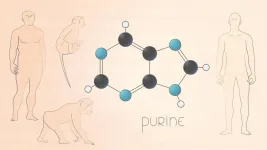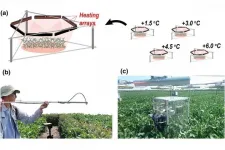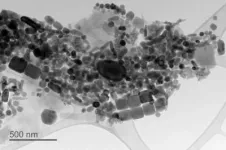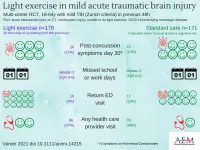Bile acids trigger satiety in the brain
EPFL scientists have discovered a new role for bile acids: they curb appetite by entering the brain.
2021-05-24
(Press-News.org) Our brain is usually well protected from uncontrolled influx of molecules from the periphery thanks to the blood-brain barrier, a physical seal of cells lining the blood vessel walls. The hypothalamus, however, is a notable exception to this rule. Characterized by "leaky" blood vessels, this region, located at the base of the brain, is exposed to a variety of circulating bioactive molecules. This anatomical feature also determines its function as a rheostat involved in the coordination of energy sensing and feeding behavior.
Several hormones and nutrients are known to influence the feeding neurocircuit in the hypothalamus. Classic examples are leptin and insulin, both involved in informing the brain of available energy. In the last years, the list of appetite- or satiety-triggering signals has been steadily growing with the identification of several gut hormones. Those are involved in fine-tuning feeding behaviour by regulating the perception of hunger or satiety, ultimately leading to the initiation or termination of a meal. The gut-brain axis is thus a critical gatekeeper in regulating feeding behavior.
Bile acids are among the most abundant metabolites in the gut and act as versatile signalling molecules that relay nutrient availability to a physiological response by activating the bile acid responsive membrane receptor, Takeda G-coupled receptor 5 (TGR5). Although the ancient Greeks already postulated that bile may affect our state of mind, we know very little about the signaling role of these metabolites in the brain.
In a new study from the Schoonjans' lab at EPFL, together with the EPFL Brain Mind Institute and Bertarelli Platform for Gene Therapy, and several collaborators from France, Italy and the US, the authors showed that bile acids reach the mouse brain shortly after a meal to suppress food intake. Bile acids escape the digestive tract, transiently accumulate in the blood circulation, and spike in the hypothalamus for a very short period of time after feeding. The authors demonstrated that the anorexic response of bile acids is mediated by TGR5, located at the cell surface of a distinct group of hypothalamic cells, called AgRP/NPY neurons. When focusing on this neuronal subpopulation, they found that bile acids mediate two processes staggered in time. "While bile acids acutely block the release of appetite-stimulating AgRP and NPY peptides during the first minutes following binding of their cognate receptor, they further reinforce the repression by blunting the expression of these neurotransmitters" says Alessia Perino, first-author of the paper.
Over the last two decades, bile acids have been proven to be efficacious in alleviating chronic metabolic and inflammatory disorders. Previous studies from the Schoonjans lab demonstrated that systemic TGR5 activation attenuates obesity in diet-induced obese mice. The current study reveals that the bile acid-TGR5 signaling axis is not only important in disease, but also in the physiological control of eating behavior. In the absence of dietary fat, bile acids temporarily suppress food intake without affecting the normal energy balance. "This is not surprising as homeostasis is about a self-regulatory process in which systems tend to maintain stability" says Kristina Schoonjans. "In contrast, chronic high fat diet feeding may override this equilibrium. It will be interesting to find out whether the identified neurocircuits contribute to the known body weight reducing effect of bile acids in the setting of diet-induced obesity".
INFORMATION:
[Attachments] See images for this press release:
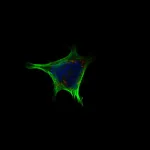
ELSE PRESS RELEASES FROM THIS DATE:
2021-05-24
Skoltech scientists and their colleagues from Germany and the United States have analyzed the metabolomes of humans, chimpanzees, and macaques in muscle, kidney, and three different brain regions. The team discovered that the modern human genome undergoes mutation which makes the adenylosuccinate lyase enzyme less stable, leading to a decrease in purine synthesis. This mutation did not occur in Neanderthals, so the scientists believe that it affected metabolism in brain tissues and thereby strongly contributed to modern humans evolving into a separate species. The research was published in the journal eLife.
The predecessors of modern humans split from their closest evolutionary relatives, Neanderthals and Denisovans, about 600,000 ...
2021-05-24
A new low-cost and sustainable technique would boost the possibilities for hospitals and clinics to deliver therapeutics with aerogels, a foam-like material now found in such high-tech applications as insulation for spacesuits and breathable plasters.
With the help of an ordinary kitchen freezer, this newest form of aerogel was made from all natural ingredients, including plant cellulose and algae, says Jowan Rostami, a researcher in fibre technology at KTH Royal Institute of Technology in Stockholm.
Rostami says that the aerogel's low density and favorable surface area make it ideal for a wide range of uses, ...
2021-05-24
CHAMPAIGN, Ill. -- Scientists report that it is possible to detect and predict heat damage in crops by measuring the fluorescent light signature of plant leaves experiencing heat stress. If collected via satellite, this fluorescent signal could support widespread monitoring of growth and crop yield under the heat stress of climate change, the researchers say.
Their study measures sun-induced chlorophyll fluorescence - or SIF - to monitor a plant's photosynthetic health and establish a connection between heat stress and crop yield. The findings are published in the journal Global Change Biology.
Sun-induced chlorophyll fluorescence occurs when a portion of photosynthetic energy, in the form of near-infrared light, is emitted from plant leaves, the researchers said.
"There ...
2021-05-24
Fifty-six million years ago, as the Earth's climate warmed by five to eight degrees C, new land mammals evolved, tropical forests expanded, giant insects and reptiles appeared and the chemistry of the ocean changed. Through it all, bacteria in the ocean in what is now New Jersey kept a record of the changes in their environment through forming tiny magnetic particles. Now, those particles and their record are all that's left of these microorganisms. Thanks to new research tools, that record is finally being read.
In research published in the journal Paleoceanography and Paleoclimatology, researchers including University of Utah doctoral student Courtney Wagner and associate professor Peter Lippert report the climate clues that can ...
2021-05-24
By making a game out of getting their daily steps, new research points to the possibility that people with diabetes could be nudged toward increasing their physical activity, with changes lasting for a full year. Since many now use apps or other digital means to manage their diabetes, this program - which utilized tools like wearable step counters and electronic scales with personalized goals - could potentially be integrated to help individuals achieve greater success. Findings from the study, conducted by a team from the Perelman School of Medicine ...
2021-05-24
Carbon is vital to the existence of all living organisms, since it forms the basis of all organic molecules that, in turn, form the basis of all living beings. While that alone is pretty impressive, it has recently found surprisingly novel applications in disciplines such as aerospace and civil engineering with the development of carbon fibers that are stronger, stiffer, and lighter than steel. Consequently, carbon fibers have taken over steel in high-performance products like aircrafts, racecars, and sports equipment.
Carbon fibers are usually combined with other materials to form ...
2021-05-24
Scientists studying a special kind of semimetals have found a material with an unusually pristine nature that could be crucial for developing powerful new quantum technologies and discovering new phases of matter.
In an open access paper published in Science Advances, Johns Hopkins physicists and colleagues at Rice University, the Vienna University of Technology (TU Wien), and the National Institute of Standards and Technology (NIST), present experimental evidence of naturally occurring quantum criticality in a material.
Criticality is the point at which a material hovers between two phases--like the slushy transition between water and ice--without ever settling. Useful materials often exploit this point. For example, air conditioners use compressors to change refrigerant ...
2021-05-24
In order to understand foodways and subsistence strategies of humans in the past, as well as distributions of ancient animal species, it is critical for archaeologists to accurately identify animal taxa in archaeological sites. Many sites across sub-Saharan Africa have fragmented and poorly preserved animal bones, leaving the majority of specimens unidentifiable. Sub-Saharan Africa is also home to the greatest diversity of bovids on Earth, including African buffalo, wildebeest, eland, and duikers, as well as domestic sheep, goat, and cattle. The sheer number of osteologically similar animals in Africa presents a major challenge for identifying animal bones.
During the past decade, archaeologists have increasingly used a bone ...
2021-05-24
Des Plaines, IL - For acute mild traumatic brain injury (mTBI), there were no differences in recovery or health care utilization outcomes with prescribed early light exercise compared to standard care. These are the results of a study titled A randomized trial comparing prescribed light exercise to standard management for emergency department patients with acute mild traumatic brain injury, to be published in the May issue of Academic Emergency Medicine (AEM) journal, a peer-reviewed journal of the Society for Academic Emergency Medicine (SAEM).
Findings of the study suggest that early light exercise may be encouraged as tolerated at emergency department discharge following mTBI, but this guidance is not sufficient ...
2021-05-24
HOUSTON ? Several Phase II clinical trials conducted by researchers from The University of Texas MD Anderson Cancer Center show promising results for patients with melanoma, breast cancer, HER2-positive tumors and ovarian cancer. The results of these studies, which will be presented at the virtual 2021 American Society of Clinical Oncology (ASCO) Annual Meeting, highlight new advances in drug therapy research to improve patient outcomes.
Combination therapy of nivolumab and relatlimab before and after surgery is effective against melanoma (Abstract #9502)
In a Phase II study, MD Anderson researchers showed that a regimen of neoadjuvant and ...
LAST 30 PRESS RELEASES:
[Press-News.org] Bile acids trigger satiety in the brain
EPFL scientists have discovered a new role for bile acids: they curb appetite by entering the brain.

